The sweetest tastes of summer come to us under hot, open skies and enclosed corridors of whispering greenery. Aimless rambles turn into intense treasure hunts when you find a single, ripe wild berry. Your hand reaches out, you taste its wild, sweet flavours and then suddenly, life is filled with purpose and excitement as you comb the surroundings for tiny, telltale splashes of colour in the dusty greenery that announce its companions. No exotic dessert or elaborate confectionary holds the same delight as naturally ripened fruit and berries plucked off a tree or shrub and popped into your mouth. The dazzling flavours and colours, concentrated by bright, hard sunshine seem to capture the essence of the season in a way that nothing else can.
The hills and slopes of Coorg are particularly blessed with a wide range of indigenous fruits and berries that appear to have been created solely for the delight of young children, birds –and the home cook. Summer berries and children are made to be best friends, and the Coorg home cook fills every available bottle and jar, with delicious preserves and jams that bring pleasure through the year.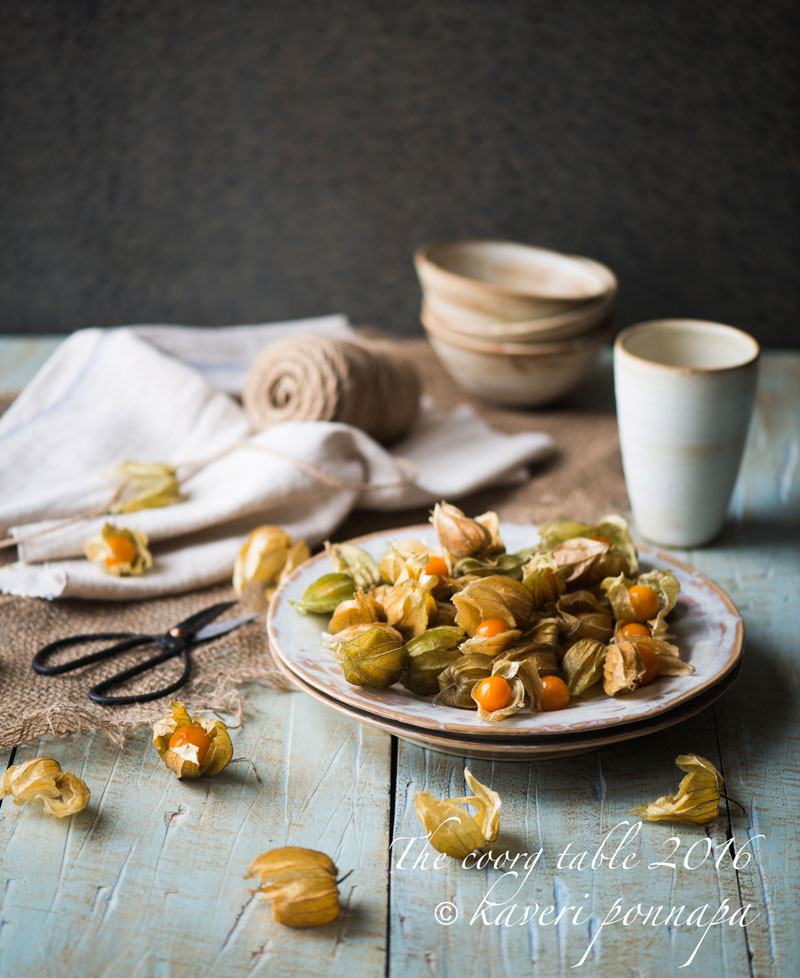
No matter how elaborate the spread at the dining table, invariably, after breakfast or lunch, we roamed the slopes and lanes on the lookout for some delicious treat to pop into our mouths. We foraged quite randomly, wandering into a small clump of trees that had a lovely little stream flowing through, passing a tempting jamun tree where we felled the fruit with stones, provoking the elderly ladies who owned the property into complaining to our grandparents about our unruly behaviour. The hedgerows that bordered all the nearby lanes offered opportunities for prized berries. Considering all these expeditions were unsupervised, it amazes me that none of us ate something toxic –but there were always older children to warn us off those plants, and the knowledge filtered down. Those early, hoarded caches of berries and fruits that we gorged on until we were satiated seem to have influenced my palate subtly. Vivid taste memories of those sharp, bright flavours I am sure are the reason that, to this day, whenever we eat out, I quickly scan the menu for a fruit based dessert. It seems to me the timeless way to end a meal, with the clear flavours of fresh fruit.
One of the delights of the Coorg summer is a South American wanderer from Peru, now a permanent resident on our hills and slopes: the Cape gooseberry. It is the prettiest, perfectly round, golden yellow or orange fruit that comes encased in a tissue thin calyx that makes it look like a miniature Chinese lantern –which is one of the many names by which it goes. Physalis peruviana flourished in South Africa where the 1902 ‘Diary of a Cape Housekeeper’ noted that a preserve made with its fruit was much appreciated by visitors from England. And that is where the ‘cape’ in its name comes from, not the attractively gauzy hull that covers the plump berry. Once it had established itself, the Cape gooseberry flourished in Coorg and became very popular in jam making, a gentle throwback to its South African heritage: in the early 1950’s, the wife of one of the English coffee planters in the district was known for the profuse hedges and walkways of Cape gooseberries she cultivated, and the quantities of jams and sauces she bottled and sold.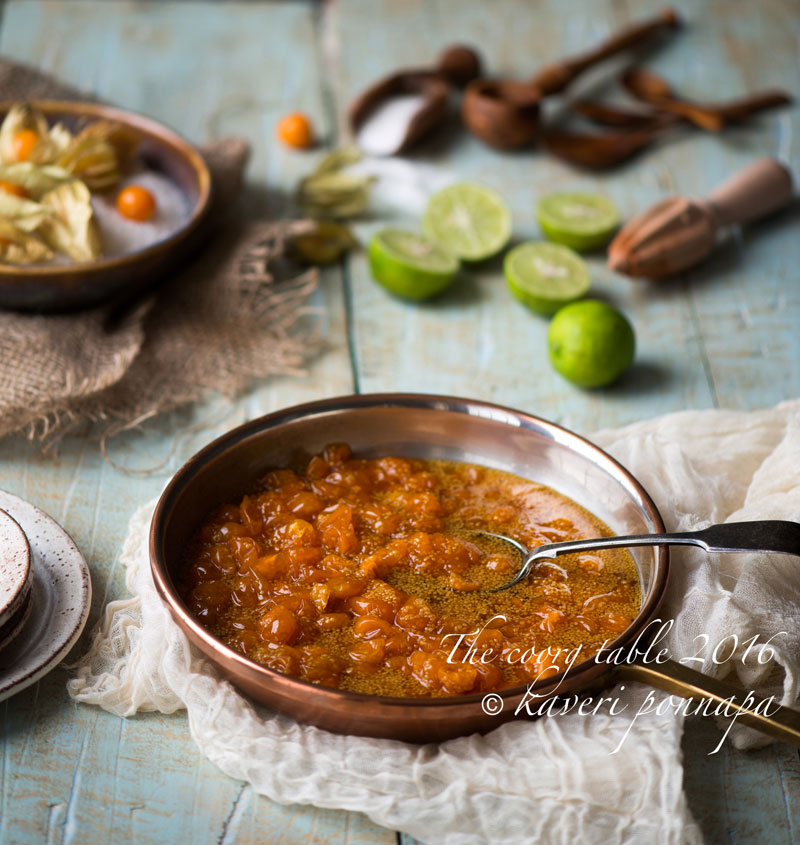
Smooth, polished to a shine and waxy, gummatte panne as it is known in Coorg is juicy, secretive and delicious. The green berry hangs encased in a pale green calyx that turns a transparent, veined buff colour as the berry ripens to a glowing orange: the contrast could not be more perfect. Small flashes of orange show through the rustling, papery cases and sometimes an entire berry hangs suspended like a tiny orange sun. With its wings twisted or folded back, it turns into an exotic tropical insect. Gummatte panne is lusciously juicy –the Hindi name, ras bhari is a perfect description. It bursts with a single bite, flooding your mouth with sweetness and an engaging sharpness at the same time, summery and sparkling.
It makes the most beautiful preserve. If you can hold back a little on the sugar, you are rewarded with the natural, lively tart character of the fruit that will find its way into your preserving jar, leaving you with a refreshing aftertaste. The juicy berries cook obligingly quickly and with very little effort, you have a pan full of softened fruit and thousands of pinprick seeds bound together in a smooth, attractive apricot coloured glaze. The cooked skins are surprisingly delicious, adding texture along with the galaxies of tiny, crunchy seeds, throwing out a teasing hint of aam papad (mango leather). The preserve goes beautifully with whipped cream, ice cream, goat’s cheese and crackers, and tarts. Dipped into chocolate, its stem and crisp calyx intact, it makes a simple, very attractive summer dessert.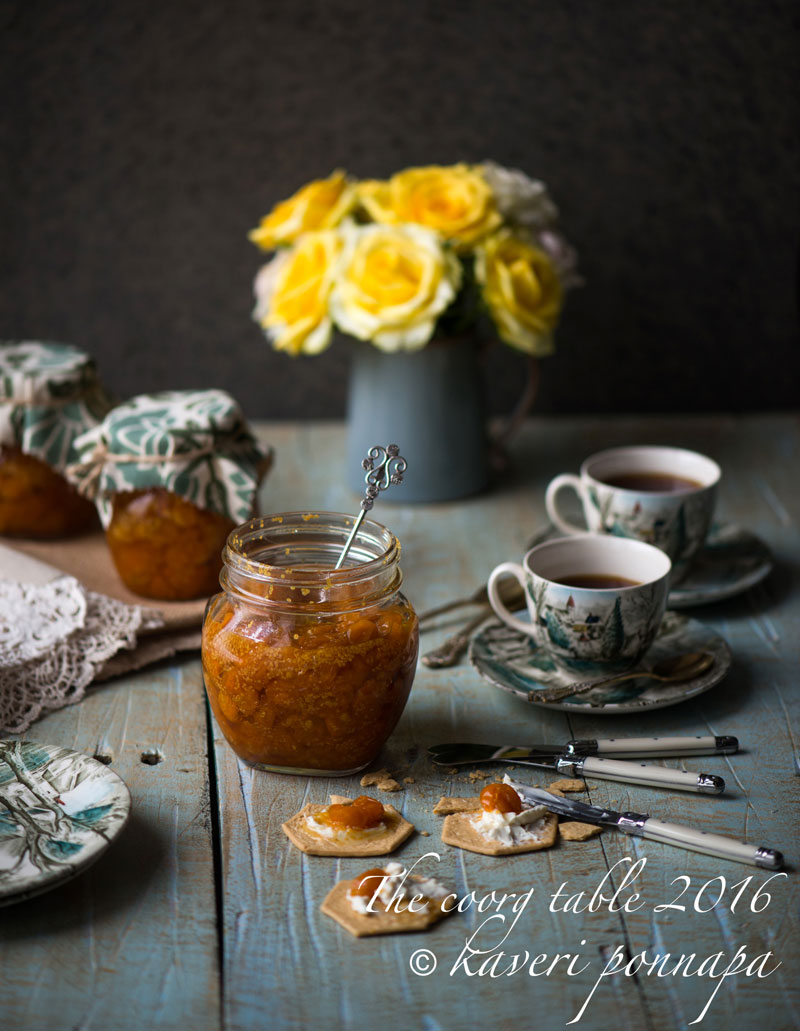 The name gummatte panne refers to the round shape of the fruit, and it’s often used as an endearment for plump little children. In my mind, this berry will forever be tied up with up with memories of summers with my children when they were very small, and we imagined they would remain that way forever. The magic of wandering around with a tiny hand held in your large one, searching for something in the garden –the look of amazement and delight when they spotted a fruit or berry and quickly plucked it for themselves. Or when they rushed up to you excitedly, their cheeks flushed with the heat and pressed a few hot, sticky, rather squashed gummatte panne berries into your hands, thrilled with themselves, and watched carefully for your reaction as you made a little ceremony of peeling back the crackling wrapping and placed a single bright berry in your mouth –all the sweetness of summer –and life –came rushing at you in that one single moment.
The name gummatte panne refers to the round shape of the fruit, and it’s often used as an endearment for plump little children. In my mind, this berry will forever be tied up with up with memories of summers with my children when they were very small, and we imagined they would remain that way forever. The magic of wandering around with a tiny hand held in your large one, searching for something in the garden –the look of amazement and delight when they spotted a fruit or berry and quickly plucked it for themselves. Or when they rushed up to you excitedly, their cheeks flushed with the heat and pressed a few hot, sticky, rather squashed gummatte panne berries into your hands, thrilled with themselves, and watched carefully for your reaction as you made a little ceremony of peeling back the crackling wrapping and placed a single bright berry in your mouth –all the sweetness of summer –and life –came rushing at you in that one single moment. 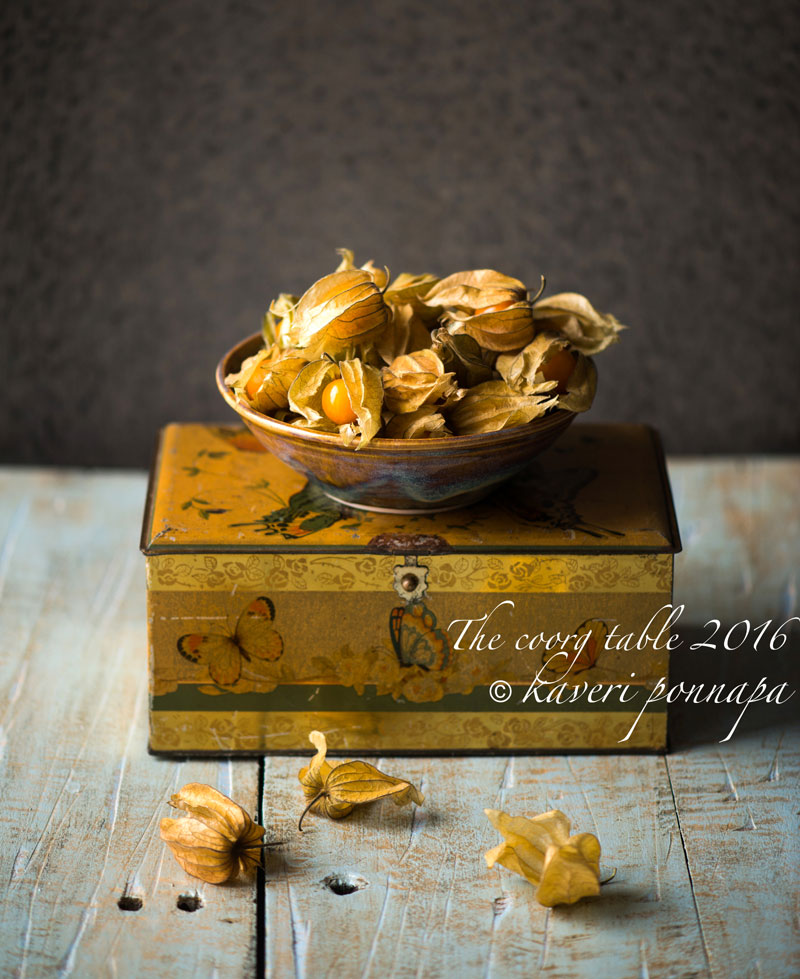
Cape Gooseberry Jam Recipe
Ingredients:
- 7 cups ripe, firm Cape gooseberries sliced in half, or pricked with a sharp knife point
- 1 ½ -2 cups granulated sugar, or more to taste
- 1 lime, or 2 passion fruits
- 2-3 tbsp water
Method:
- Hull and wash the Cape gooseberries.
- Slice in half, or prick with a sharp knifepoint, and measure 7 cups full.
- Place the fruit in a preserving pan, or a large, wide, non-reactive pan, add the 2-3 tbsp water to prevent burning, and place on a medium heat.
- The fruit will soon begin to soften and break down, and release a lot of juice.
- When you have a good quantity of liquid in the pan, add the sugar, lightly warmed. This quantity of sugar will give you a slightly tart, refreshing jam.
- Add the juice of 1 lime, or passion fruit for a lovely accent, and cook steadily of 15-20 minutes, until the mixture begins to look glazed and thickens.
- Remove from the heat while still quite liquid, as this will continue to thicken. Bottle while hot and seal.
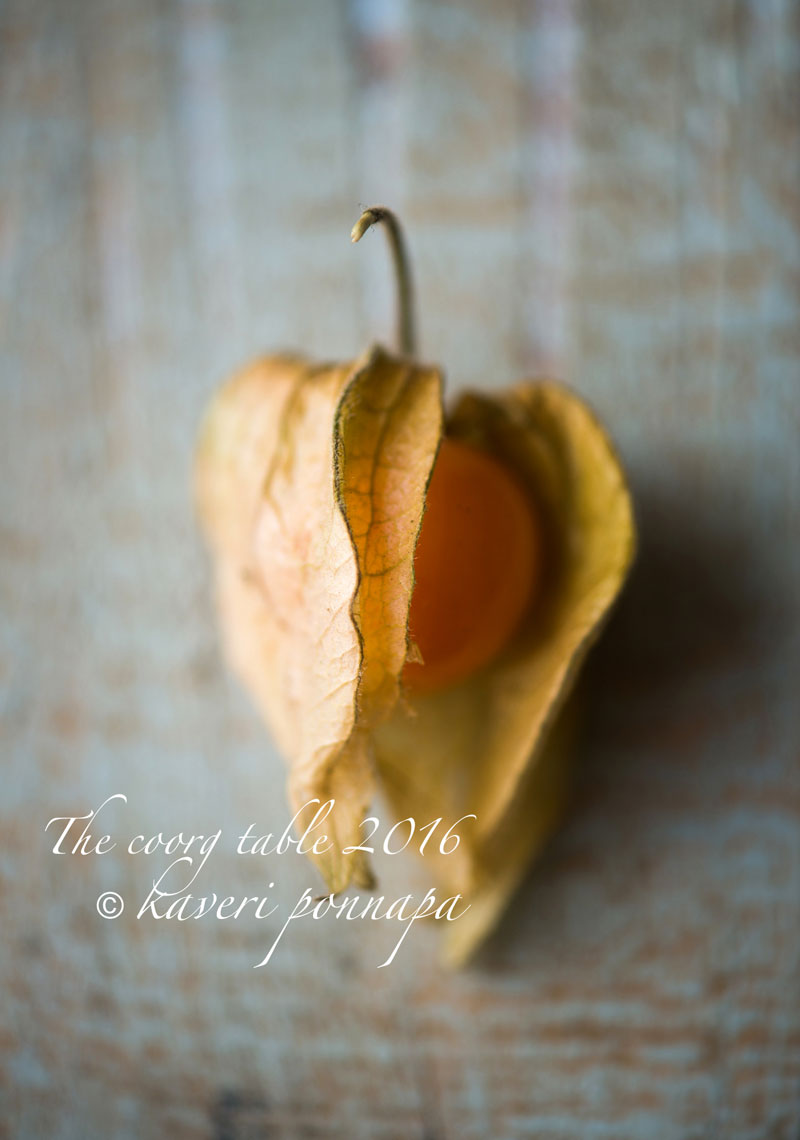
Photo Credits: Nithin Sagi
All Food Styling: Kaveri PonnapaThank you for visiting this page. If you read something that you enjoy, or see an image that you like, please take a moment to write a response. Do look out for the recipes of all the food featured here in my upcoming cookbook.
ALL MATERIAL ON THIS WEBSITE IS COPYRIGHTED: If you wish to use any of tHIS material, KINDLY WRITE TO THE AUTHOR FOR PERMISSION.

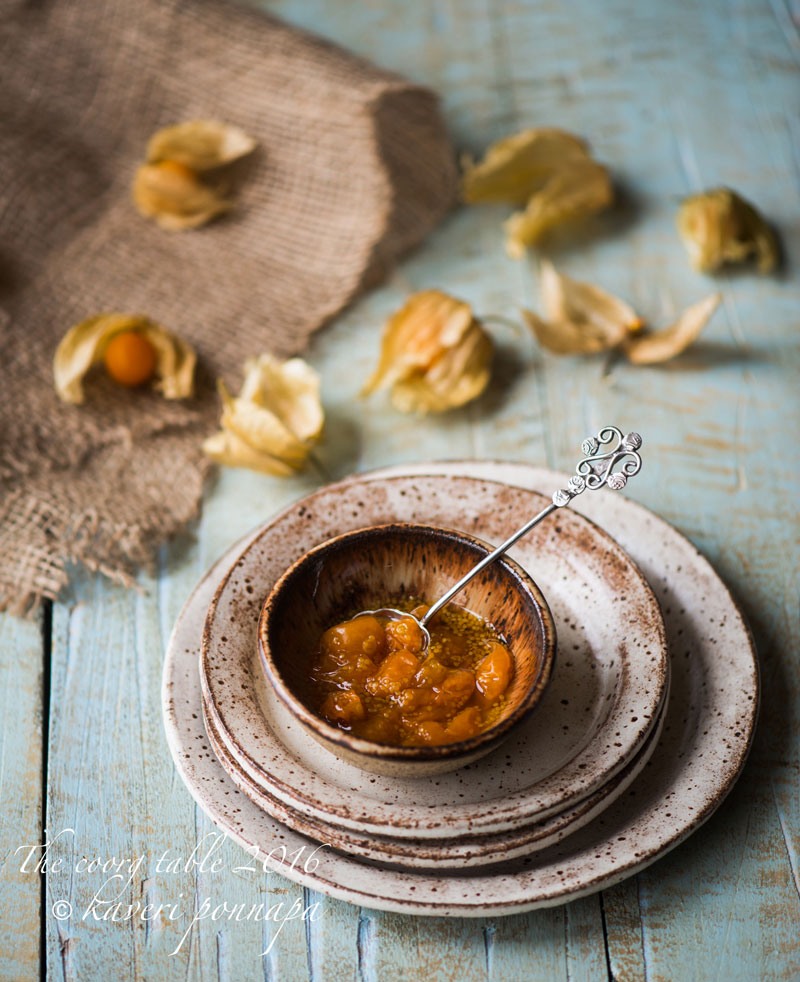
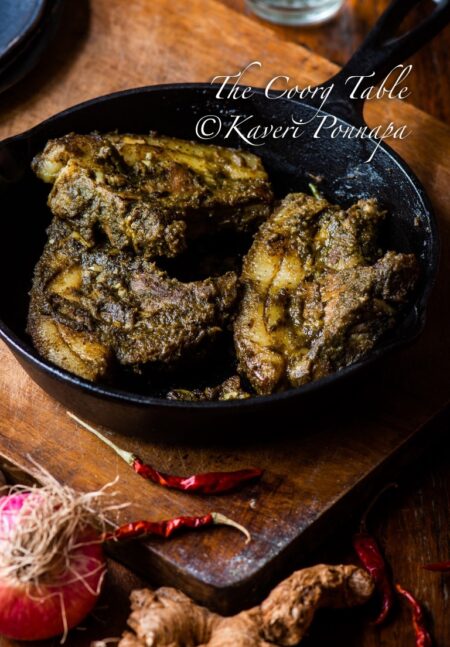


Kaveri, this recipe and the wonderful pics are superb!!
Gumatte is available in Delhi markets in winter. If I get my hands on some, I’m going to try your recipe( provided I don’t eat them up raw!)
Thank you very much, Asha! You can get gummatte panne in Bangalore, during the season too. Do look out for them and I’m sure enough will survive to go into a lovely bottle of jam! So delicious with just about everything, and perfect on vanilla ice-cream. Warm wishes.Kaveri
Hi!
As always I enjoy your write-ups and how I eventually salivate at the end of each beautiful description.
When I was in Scotland, I used to scourge the areas near the canals and the Lochs for wild Blackberries n raspberries and make several bottles of preserves. Along with those was the hunt for ripe elderberries, another delicious preserve and absolutely gorgeous in flavour n colour. This recipe of yours made me nostalgic of those times. I must give this a try when in season although mine would be from the supermarket 😊 Someday I hope I get to taste your coorg cooking!😊
Cheers.
Miny
Hello Miny, how lucky to have been able to gather wild berries and make your own preserves. I can imagine just how delicious they were, and how intense the flavours. I only seem to enjoy homemade preserves for just those reasons. Do try out the recipe here, it’s simplicity itself, and perfect on just about anything. I would love to share my home cooked Coorg dishes with you someday, I hope that I can. Do write anytime you enjoy a post, I would be happy to hear from you. Best wishes.Kaveri
As you know cooking is not one of my talents, but each time I read one of your articles it makes me want to try making the delicious foods mentioned in the article. The description is so alive one can almost feel part of the occasion. Love, Maria
That’s the idea, Maria, food can please you in all kinds of different ways. Sometimes just the process of cooking is even more enjoyable than eating, and if I can make people feel part of that experience, then it makes me very happy. I hope there will always be something that captures your attention on this page. xoxo Kaveri
Very interesting article along with nice pictorial views.
Hello Anesh, thank you, I’m so glad you enjoyed reading this post. Do keep reading these pages. Best wishes. Kaveri
Dear Kaveri, Greetings from New York. Your Coorg Table samplings and fabulous photos are mouth watering. I grew up in New England and fondly remember collecting fruits and berries for my Mother’s kitchen early each fall. It was also great fun using your finger to test the cooking process. We have not had the privilege of tasting gooseberry jam but your wonderful article makes it a promise. Warm regards. John
How fortunate to have grown up in new England, John, I can just picture how beautiful the countryside must have been in Fall. And I can also imagine all the tasting and testing that went on during jam making, that’s almost the best part of the process. Cape gooseberries make a wonderful jam, all that summer sweetness mixed up with sharp, tart notes that are simply perfect. You can eat it by itself with fresh cream, it makes a beautiful summer dessert and so many other ways too. I’m really happy that you enjoyed this post, Warm wishes.
Kaveri
I really wanna make this jam! I tried to find Cape gooseberries yesterday and today but fruit vendors in Chennai said it is only available in Pondicherry (I don’t know why). Will try to get them somehow and make the jam! We have Physalis alkekengi var. franchetii (looks similar but inedible) in Japan and this is also ones of the symbols of Summer.
Welcome to The Coorg Table Akemi – I know that you will love the sour-sweet flavours of this jam. It’s very interesting what you say about the inedible varieties of this fruit. I was speaking with an elderly and very knowledgable person recently, and came up with two very similar, but inedible varieties of this fruit that grow wild in Coorg. It sounds so similar to what you have described. And as for summer, there is another full month of this fruit left, in Coorg! Some fruit vendors here sell Cape gooseberries imported from Colombia -very nice, but the price! I hope that you manage to find some reasonably priced fruit, because this jam is worth having on your table. Warm wishes, Kaveri.
Very long back I had Gummate panne now a days its very rare to see this fruit….I was not knowing that we can prepare Jam from this fruit….wow nice!!
Hi Kaverappa, I am sure that if you looked around, you would find plenty of Gummatte panne in Coorg. But you are right, it is less visible than it used to be. Why don’t you try planting some? It grows easily, and very well – and the jam is so simple to prepare, absolutely delicious! Warm wishes. Kaveri
I really wanna make this jam!
I tried to find Cape gooseberries yesterday and today but fruit vendors in Chennai said it is only available in Pondicherry (I don’t know why).
Will try to ged them somehow and make the jam!
We have Physalis alkekengi var. franchetii (looks similar but inedible) in Japan and this is also ones of the symbols of Summer.
I just love this recipe.I am reminded of the one I make very similar but I add cloves and cinnamon and blend it with malt whiskey and let it mature in the refrigerator for two week and hola it comes out super.. Kaveri your posts are always inspirational and tease the palate of any foodie.Continue to tease us like this and one day feed us too.We love you.Stay blessed the ever wonderful culinary queen.
Hi Ashish, thanks you so much for your very generous words, they mean the world. I have spent the last several minutes imagining what malt whiskey would do to the jam – absolutely wonderful things, I feel! Your recipes are always surprising and quite special. I will certainly try out your version with the next batch of fruit I get from Coorg.In the meanwhile, I am stocking up on many good things that I hope my friends will come and share, sitting around the Coorg Table. Warm wishes. Kaveri
My intoduction to gooseberries was a woman in Mysore selling them, her only product and people so enthusiastic to find them.Thank for my continued insight .
Thank you
Hello Genevieve, I wish I could have seen the woman you met, selling Cape gooseberries, it’s not such a common sight now, thanks for sharing. These days they come in neat baskets from Colombia, but Cape gooseberries grow prolifically in many parts of the country. I love the ones from Coorg, with all the memories they bring with them. I hope you get a chance to try the jam. Do keep visiting these pages. Warm wishes.Kaveri
My mother used to make this at our home in Dehra Dun. This is one jam that I still can not resist and your writeup reads so well. Good wishes.
Hello Ashish, welcome to The Coorg Table. This is a jam so full of fresh, berry flavours, typical of the hills.I can understand how it has stayed in your memory. I’m so glad you enjoyed the post, please do keep visiting these pages. Warm wishes. Kaveri
yes, gooseberries are special. They are always at the nilgiri fruit shop on Brigade road in February ( at exactly the same time when the first jacaranda trees bloom) and i always make jam tarts then!! will sadly have to wait now to lay my hands on some and try this jam.Thank you Kaveri.
Hi Sonali, yes,Cape gooseberries make the most delicious jam tarts, and so many other fresh, summer desserts too. They flourish in Coorg at this time, and they may still be in the market now. In case you can’t find the fruit, you know where you can get a bottle of home made jam! Warm wishes. Kaveri